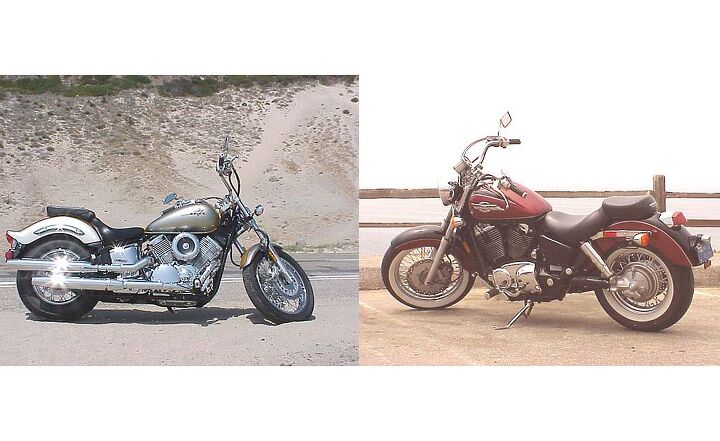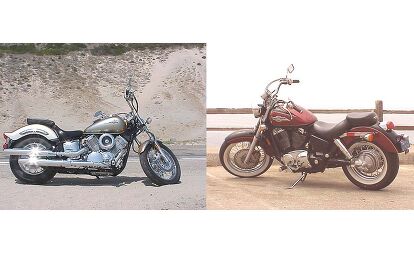Church Of MO – Honda Shadow A.C.E. V. Yamaha V-Star 1100

Like their sportbike cousins, middleweight cruisers provide nearly as much pleasure as their big-displacement counterparts, but have the benefit of lighter weight and better maneuverability. Two middleweight cruisers that are reliable as a rock, though perhaps a little bland, the Honda Shadow ACE and Yamaha V-Star 1100 are solid mid-displacement cruisers that are just as fine today as they were back in 2004, when we pit the two against each other. On the surface they may look fairly similar, but dig deeper and the two go about cruising in notably different ways. Here’s the MO crew of 2004 to tell you more.
Honda Shadow A.C.E. V. Yamaha V-Star 1100
By Staff, Apr. 25, 2004
You want a big cruiser but you don’t need a large 1500 cc behemoth that weighs close to half-a-ton fully loaded. You want something you can cruise down the boulevard on but you want to be able to handle a corner or two. You want classic styling but you insist on reliability as well. If these are your guidelines, then Honda and Yamaha might have what you’re looking for in the guise of the Honda Shadow American Classic Edition and Yamaha V-Star 1100. The ACE and V-Star have a few things in common: Both sport requisite V-twin powerplants (75° for the V-Star and 45° for the ACE) and both possess typical Japanese refinement. Aside from these similarities, the two rides are very different machines.
While both machines are shaft driven, the ACE uses the shaft housing as the swingarm. Although this arrangement is effective, it’s a bit lacking style-wise. However, the whitewall tires and the classic fenders and tank help to create a traditional design that turns heads when you’re out and about. The V-Star uses a different approach, utilizing a pivoting sub-frame design with a hidden mono-shock that keeps the lines fluid and consistent with the rest of the bike.
Although this beast isn’t equipped with whitewall tires, it still cuts a graceful, glittering profile. The only flaw we noticed was the small headlight that looked like it was swapped from the smaller, V-Star 650. Looking at both machines, we noticed the gobs of chrome mounted shamelessly around the engine case and exhaust pipes. Both machines had various bits of chrome-colored plastic and chromed steel hiding ugly spots yet contributing to its overall glimmer.
The exhaust pipes on both machines were covered in chromed sheet metal. While the majority of this bright work looked oh-so-fine, there were certain areas that seemed to a certain extent tacky, notably at the cylinders heads.
After mounting each bike we proceeded to look for the ignition switches. The V-Star placed the switch on the right side, right behind the steering column. The V-Star ignition switch also has an integrated fork lock for added security. The ACE has the switch behind the rider’s left leg, camouflaged in a chrome cover. The fork lock for the ACE is located separately underneath the triple clamps.
The traditional and utilitarian ACE speedo, mounted on the handlebars, suffered a bit by comparison and looked as if it were an afterthought, something forgotten by a haphazard engineer. Both rides also had lengths of clutch and other cabling emanating from the grips. However on the ACE it looked more like insect antennae. The V-Star at least clipped the groups of cable together, making a somewhat neater package.
The ACE is water-cooled. Those wonderful cylinder fins are primarily ornamental, although they probably do reduce engine temperature since the radiator fan would engage only momentarily after the bike was stationary after a brisk ride. The V-Star on the other hand is completely air-cooled. Both bikes started right away. The V-Star responded immediately to throttle input, but the ACE bogged down when throttle was initially applied, however after a few minutes of relaxed riding the ACE had the necessary warm-up time to smoothly respond to throttle changes.
“Merging onto the freeway we realized that these twins share one more attribute: These bikes got some giddy-up.” They’re not sport bikes, definitely, but they did have enough acceleration for all our merging and, more importantly, passing requirements. And very well they should.
Although the ACE felt like it had more power, the V-Star actually had approximately 5 more horsepower than the V-Star. The ACE had approximately 45 horsepower, while the V-Star had approximately 50 horses on tap.
The ACE has a transistorized ignition system, which employs a three-valve system with one intake and two exhaust valves with two spark plugs per cylinder. It is said that this three-valve system has a twenty-percent larger area then a similar two-valve system. While we were not able to measure torque (the Bartels H-D dyno is dying a slow and agonizing death), the ACE does feel like it delivers a little more punch than the V-Star. In comparison the V-Star uses a standard two-valve, one plug-per-cylinder arrangement. While seemingly simple in nature, the carburetor is fitted with a throttle position sensor to help keep things dialed in.
Accelerating and shifting were easy. The ACE implements a heel-toe shift lever, while the V-Star uses a standard shifter. Both used five-speed transmissions that performed without flaw. At speed we noticed the ACE produced considerable amounts of buzzing in the footpegs and seat area. This became extremely uncomfortable after a few minutes down the road but only occurred at highway speeds and is probably due to its single-pinned crank. The V-Star, on the other hand, felt much smoother. Thankfully not much of anything could be felt through the bars of either machines because they both have rubber mounted handlebars.
As we began to hit traffic, we realized a very important thing: Three brake disks are better than two! The V-Star has two 298mm disks up front each bound by a two-piston caliper and a 282mm disk in the back with a single piston caliper. These babies really do help the V-Star slow down all 580 lbs of metal at speed.
The ACE on the other hand, with its single 316mm disk in the front with a two-piston caliper and 276mm disk in the back also bound by a single piston caliper, felt vague and needed more input.
You feel much lower to the ground on the V-Star even though its seat height is only 0.5 inches less than the ACE’s. Both are neutral steering and don’t mind being leaned over. The V-Star had the advantage in this category because the ACE didn’t respond well to mid-corner bumps. However, while it was fun to toss around these heavy cruisers in the twisties, that’s not what these machines were meant for. We needed to do some boulevard cruising, and of course, see how well they perform with a passenger.
“Handling-wise, both cruisers were somewhat similar.”
Both handled adequately under two-up conditions although the V-Star’s suspension compressed and it dragged peg a little to frequently while the ACE’s power seemed to bog down. Although both front seats looked cozy enough, looks can be deceiving. While neither bike comes with a front seat that threatens to dilute the aftermarket, we preferred the V-Star’s seat to the ACE’s. The pillion pads, on the other hand, not only looked uncompromising, they were. After about an hour our pillion passenger on the ACE dismounted in pain. The V-Star wasn’t as bad, and the passenger lasted for one-and-a-half hours.
While the V-Star’s seats, both rider and pillion, were a tad more comfortable than ACE’s, the V-Star saddle still looked and felt like a large bicycle seat. It was uncomfortable on longer hauls, although there was still enough room to move around and stretch out. A nice feature of the V-Star was the rise at the back of the saddle that feels like a small back rest.
The V-Star also had narrower handlebars than the ACE that were better in traffic. The bars on the ACE are too wide and a little unnerving for splitting lanes through congested traffic.
Not only was the V-Star a smoother ride in comparison to the ACE, we received more compliments about the V-Star’s styling than than we did with the ACE’s. Our V-Star’s elegant, gold and silver paint scheme consistently attracted attention, even from more than a few American heavyweight cruiser groupies.
The ACE is not an unattractive bike, it just seems to come across to some, including the MO staff, as a little bland. Then again, beauty is in the eye of the beholder.
In the end we realized that either bike would be a good addition to any livery for those who are looking to upgrade from smaller cruisers. However, with its lighter and more responsive handling, smoother ride, all-around better looks and a $200.00 (USD) less price tag, we have to go with Yamaha’s V-Star 1100 over Honda’s venerable and serviceable Shadow ACE 1100. After what seems like learning their lessons from their Royal Star experience, Yamaha has gone back to basics and created an excellent package with their V-Star line of light and middleweight cruisers, offering performance, comfort, handling, a very stylish package for an excellent price. Now, if only Yamaha can do something with that headlight.
| Manufacturer : Model : Price : Engine : Displacement : Bore and Stroke : Carburetion : Transmission : Wheelbase : Seat Height : Dry Weight : Fuel Capacity : Front Tire : Rear Tire : Colors Available : | Honda Shadow ACE VT1100C2 $7,999 msrp Liquid Cooled, OHC, 45° V twin 1099.2cc 87.5mm X 91.4mm Dual 36mm CV 5 Speed Constant Mesh 64.8″ 27.5″ 575.4 lbs (listed) 4.8 gallons 120/90-18 170/80-15 Black/Pearl Dark Red Black/Orange Black | Yamaha V-Star 1100 $7,799 msrp Air Cooled, SOHC, 75° V twin 1063cc 95mm X 75mm Single 37mm Mikuni Downdraft w/ TPS 5 Speed 64.5″ 27″ 571 lbs (listed) 4.6 gallons 110/90-18 170/80-15 Stardust Silver/Sunrise Gold Cherry Red/Cranberry Red Black |

Troy's been riding motorcycles and writing about them since 2006, getting his start at Rider Magazine. From there, he moved to Sport Rider Magazine before finally landing at Motorcycle.com in 2011. A lifelong gearhead who didn't fully immerse himself in motorcycles until his teenage years, Troy's interests have always been in technology, performance, and going fast. Naturally, racing was the perfect avenue to combine all three. Troy has been racing nearly as long as he's been riding and has competed at the AMA national level. He's also won multiple club races throughout the country, culminating in a Utah Sport Bike Association championship in 2011. He has been invited as a guest instructor for the Yamaha Champions Riding School, and when he's not out riding, he's either wrenching on bikes or watching MotoGP.
More by Troy Siahaan




























































Comments
Join the conversation